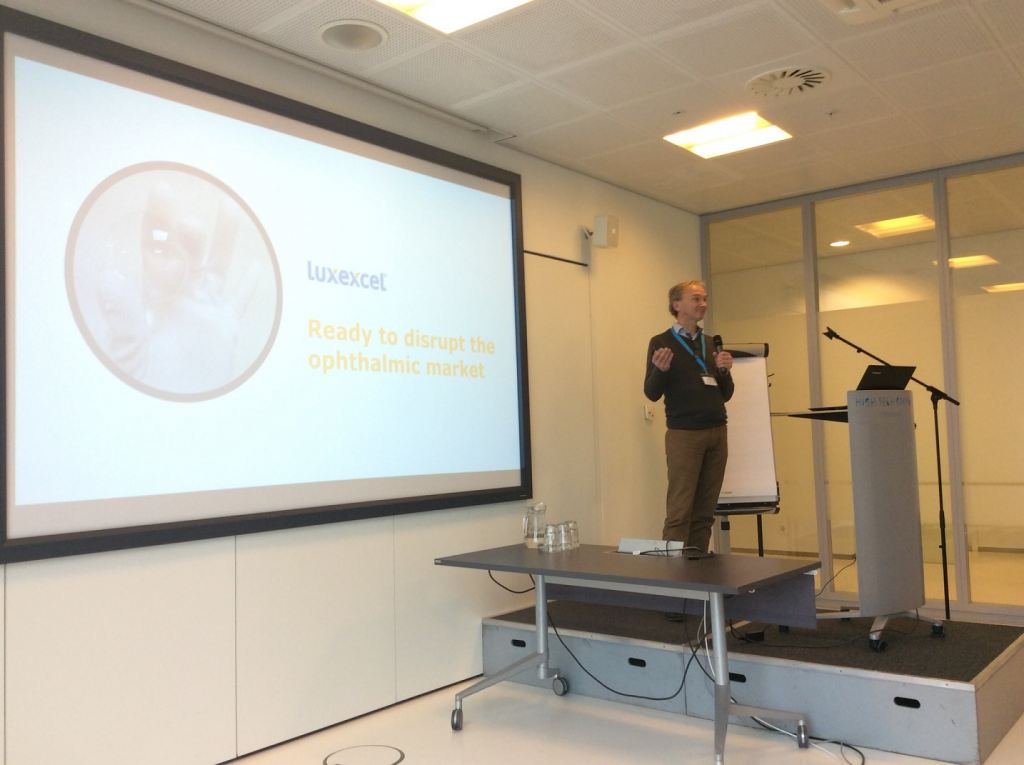
A pair of glasses which automatically turns to a darker shade when it sees too much of the sun, or one that sounds the alarm when the person wearing is in danger of falling asleep while driving. The 3d Printing Electronics Conference at High Tech Campus Eindhoven past Tuesday shed some interesting light on the developments and possibillities of 3d-printing.
The lenses are just one example out of a broad spectrum of innovations which are ready to be used thanks to 3d-printing. It is however, a rare one. The 3d-printed goggles –made at High Tech Campus Eindhoven– are a clear example of an innovation that is ready to go to market any time soon.
Most innovations seem abstract at first. This has to do with the technique still being very young. The market that its operating in, still is a niche. Which is exactly the reason why 3d Printing Electronics Conference took place on Tuesday, even though it is the fourth edition of the conference.
Spotlight
Pieter Hermans, responsible for organizing the event on behalf of Jakajima BV, underlines the goal of the conference. “We want parties to connect, in an area where it can be hard to find a good match.” 3d-printing being a highly technical field, can be an area where this is the case. “We offer a podium on which we put the spotlight on this niche market.”
That light is still needed, like it is in every innovation. “The printing is slowly evolving to a grown-up market and industry”, Hermans says. “Integrating 3d-printing in the production process is something that is bound to happen. We are just not sure how far away that landmark is.”
In fact, no one seems sure. This became clear in the chance meetings that happened in between the presentations and talks. This seems due to the fact that the final steps of developing a new technique are just as hard -if not harder- than the first steps which lead to inventing a new way of working.
Over 90 attendees #3dprinting #electronics conference @hightechcampus on integrated additive manufacturing, 3dprinted batteries and sensors pic.twitter.com/3uMYWT7ivz
— 3D Print Electronics (@3DPelectronics) 24 januari 2017
Aiming for a market
This seems inherent to innovating, Marcel Grooten, Managing Director at DoMicro BV has a seat in Printed Electronics NL, several of its members had demos on display during the event. He explains: “It is one thing to bake some bread, but how much good is that going to do if you don’t have a bakery?”, he says. “An entire infrastructure is needed to get the production process and development of all possible applications going.”
Eindhoven seems to be a place where that infrastructure could exist. That is what drew Thomas Ulleberg all the way from Trondheim, Norway, to Eindhoven. “We see a lot of potential and development here. The greatest challenge lies in going to a market. That is the real race. That is what is most interesting now.”
The use of innovating
3d-printing seems to be ready for it. The use of the innovation seems clear. An example: Guido Groet, Chief Marketing Officer at Luxexcel in Eindhoven –the company that makes the special glasses- holds a 3d-printed lens the size of a fully grown hand. In a world where 3d-printing does not exist, these lenses are made in Asia and transported all over the world.
“Then, a total of 80 percent of the lens will be thrown in the garbage because it can not be used, the wishes of each client are too specific.” 3d-printing will solve two problems here: It is no longer necessary to use polluting transport to move the lenses because they can be made in any place, also the precision that can be achieved by printing will make sure the waste of the lenses will go down dramatically.
These are only two examples of the things 3d-printing can bring. But they touch on the values of innovation at its core. De Groet in his presentation: “We want to do what is not yet possible, but we are getting there.”
